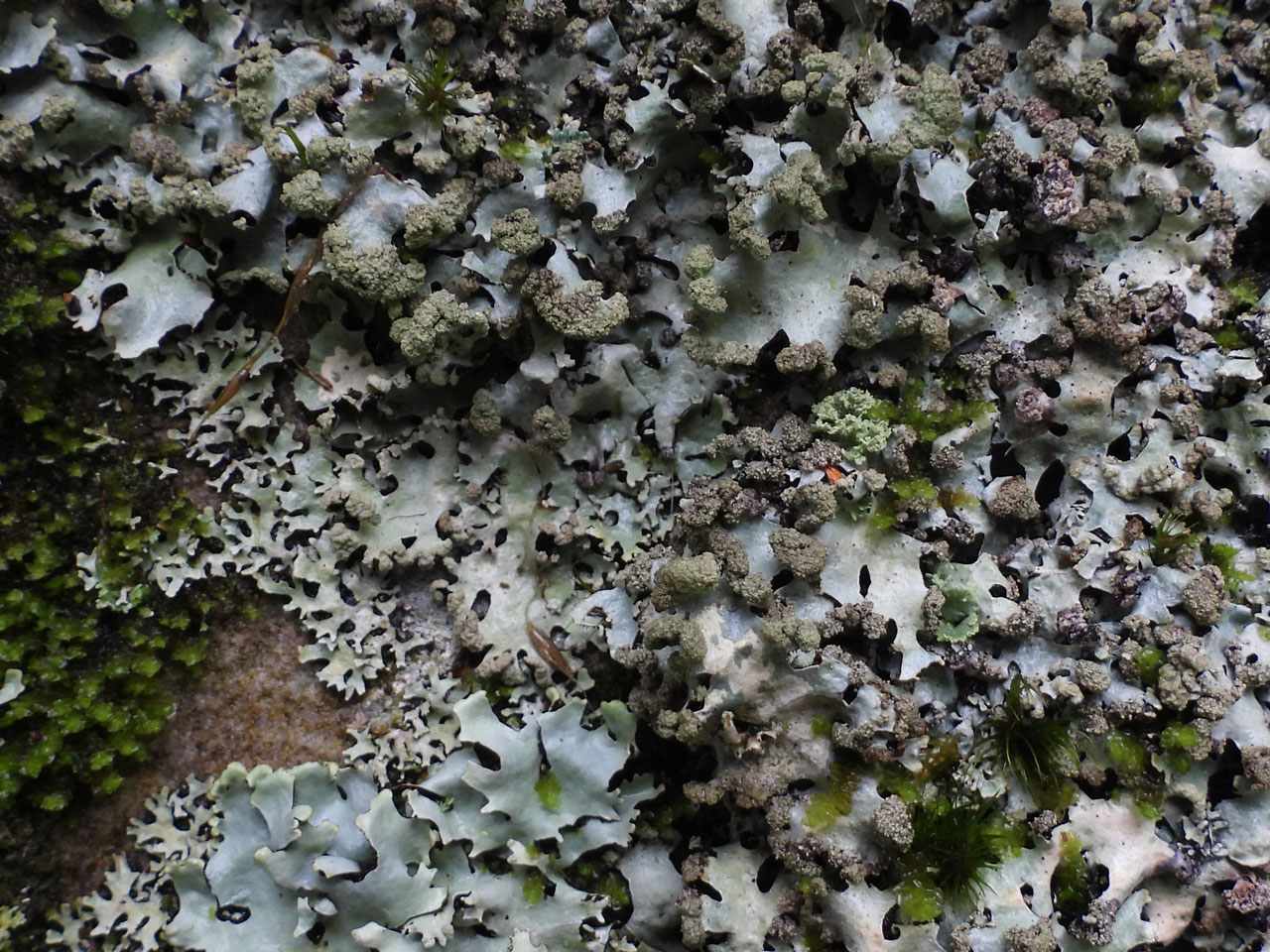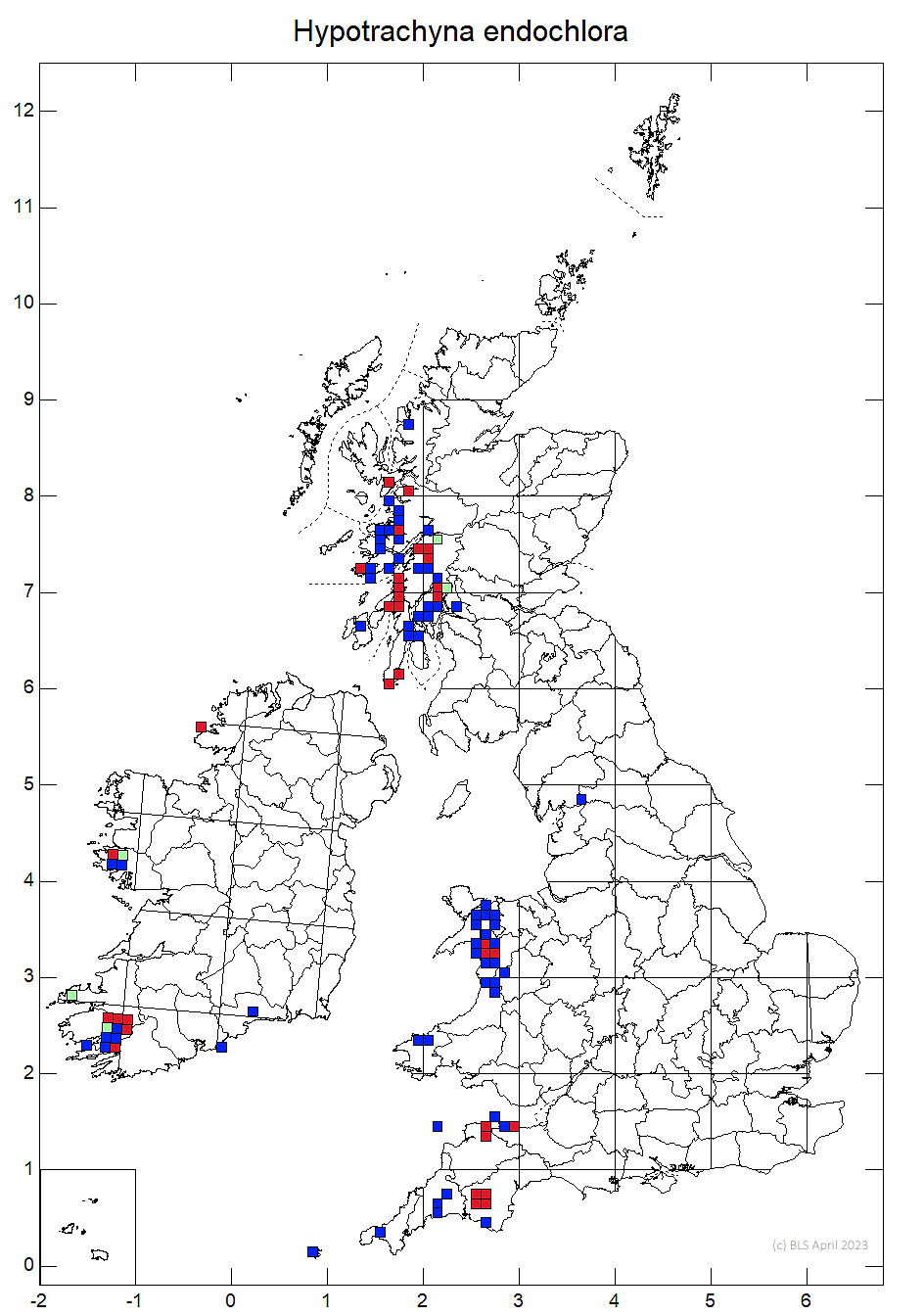A rather local, probably under recorded, Hypotrachyna of temperate rainforests. The most diagnostic feature is the pale pale lemon yellow medulla but this only visible in damaged or scratched thalli. Finding it among the usual associated abundance of Hypotrachyna laevigata needs experience. Look for thalli that have shorter more densely set lobes, with conspicuous capitate soralia, looking a bit like more like an overgrown Hypotrachyna revoluta/afrorevoluta thalli than Hypotrachyna laevigata.
Thallus moderately to loosely adnate, (3–) 6–13 cm diam.; lobes ± imbricate, sublinear, 1–4 (–6) mm broad; subirregularly branched with a thin black margin, sinuous in axils, apices truncate or sometimes pointed; margins entire or rarely lobulate or laciniate-incised; upper surface pale mineral grey or yellow-grey, smooth or occasionally finely foveolate, sometimes pruinose, white-maculate, sorediate; soralia ± pustulate at the apices or ± capitate with diffuse soredia, occasionally extending laminally; soredia coarsely granular, rarely becoming lobulate; cortex ± becoming blackened and eroded and sometimes fragile and flaking. Medulla pale lemon yellow or almost lime green; lower cortex black, shiny, smooth to rugulose, with a brown marginal zone, moderate to densely rhizinate; rhizines densely dichotomously or rarely squarrosely branched, growing horizontally from the margins, more rarely projecting as a dense mat. Apothecia rare, 3–14 mm diam., with ascospores 18–22 × 9–14 μm. Pycnidia subterminal and laminal; conidia bifusiform, 5–6.5 × ca 1 μm. Cortex K+ yellow; medulla C+ orange, K–, KC+ orange, Pd– [atranorin, obtusatic acid (major), chloroatranorin, barbatic, secalonic A, and norobtusatic acids (minor/trace)].
Characterised by the sublinear, mineral grey to yellowish/grey lobes, the ± terminal, diffuse ± pustulate soredia and by the lemon-yellow or lime-green medulla (due to presence of the pigment secalonic acid A). The latter character, especially, distinguishes it from H. laevigata. The upper surface sometimes becomes densely lobulate centrally, especially so for Scottish specimens.
Phylogenetic study has shown that this is not a monophyletic species, and additional research is needed to clarify the species boundary (Kirika et al. 2019).
On trees (Oak, Birch, etc) in woodlands with well-lit leached very acid bark (pH 3.5-4.0); also in Sallow scrub, on mossy rocks and in coastal cliff-top Armeria heaths, in areas of very high rainfall.

Rather local and infrequent, W. & S.W. Britain and Ireland.
A very localised and sparsely recorded species, largely restricted to temperate rainforests. It is likely vulnerable to declines in habitat quality, but baseline data appears limited.
Britain: Notable & International Responsibility species
Scotland: Priority Taxon for Biodiversity in Scotland
Cannon, P., Divakar, P., Yahr, R., Aptroot, A., Clerc, P., Coppins, B., Fryday, A., Sanderson, N. & Simkin, J. (2023). Lecanorales: Parmeliaceae, including the genera Alectoria, Allantoparmelia, Arctoparmelia, Brodoa, Bryoria, Cetraria, Cetrariella, Cetrelia, Cornicularia, Evernia, Flavocetraria, Flavoparmelia, Hypogymnia, Hypotrachyna, Imshaugia, Melanelia, Melanelixia, Melanohalea, Menegazzia, Montanelia, Nesolechia, Parmelia, Parmelina, Parmeliopsis, Parmotrema, Platismatia, Pleurosticta, Protoparmelia, Pseudephebe, Pseudevernia, Punctelia, Raesaenenia, Tuckermannopsis, Usnea, Vulpicida and Xanthoparmelia. Revisions of British and Irish Lichens 33: 1-98.
Kirika, P.M., Divakar, P.K., Crespo, A. & Lumbsch, H.T. (2019). Molecular and phenotypical studies on species diversity of Hypotrachyna (Parmeliaceae, Ascomycota) in Kenya, East Africa. Bryologist 122: 140–
150.
Text by N A Sanderson, based on Cannon et al (2023).


